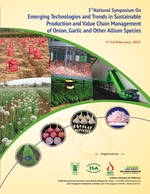Fertilizers and manures
Nutrient removal by onion crop mainly depends upon bulb yield, variety, quantity of fertilizers applied, soil condition and season. The results of the experiment carried out at DOGR, Rajgurunagar showed that onion crop removes about 90-95 kg of N, 30-35 kg of P2O5, and 50-55 kg of K2O to produce 40 t onion bulbs/ha. Therefore, it is necessary to apply plant nutrients in a balanced manner externally through different sources for sustainable onion production and soil health. Based on the results of field experiments conducted at DOGR, recommended doses of organic manures and fertilizers have been standardized and presented in Table 3. Fertilizer requirement of long day onion (grown in the hills) is higher than the short day onion crop due to its longer crop duration and yield potential.
Fertilizer schedule for onion (per ha)
|
Schedule |
N |
P2O5 |
K2O |
Organic manures |
|
Kharif onion (Yield potential – 25-30 t/ha) |
||||
|
Basal |
25 kg |
40 kg |
40 kg |
Organic manures equivalent to 75 kg N (FYM – Approx. 15 t/ha or Poultry manure- Approx. 7.5 t/ha or Vermicompost – Approx. 7.5 t/ha) |
|
30 DAT |
25 kg |
- |
- |
- |
|
45 DAT |
25 kg |
- |
- |
- |
|
Total |
75 kg |
40 kg |
40 kg |
- |
|
Late Kharif and Rabi onion (Yield potential- 40-50 t/ha) |
||||
|
Basal |
40 kg |
40 kg |
60 kg |
Organic manures equivalent to 75 kg N (FYM – Approx. 15 t/ha or Poultry manure- Approx. 7.5 t/ha or Vermicompost – Approx. 7.5 t/ha) |
|
30 DAT |
35 kg |
- |
- |
|
|
45 DAT |
35 kg |
- |
- |
|
|
Total |
110 kg |
40 kg |
60 kg |
|
|
Long day onion (Yield potential-100 t/ha) |
||||
|
Basal |
60 kg |
60 kg |
70 kg |
Organic manures equivalent to 75 kg N (FYM – Approx. 15 t/ha or Poultry manure- Approx. 7.5 t/ha or Vermicompost – Approx. 7.5 t/ha) |
|
30 DAT |
60 kg |
- |
- |
|
|
60 DAT |
60 kg |
- |
- |
|
|
Total |
180 kg |
60 kg |
70 kg |
|
One third of recommended N and full dose of P2O5 and K2O are applied at the time of planting while remaining two third N is applied in two equal splits at 30 and 45 days after planting.
Sulphur management
In addition to NPK, sulphur is also an essential plant nutrient important for onion crop for improving yield and the pungency of onion bulbs.
• Sulphur is recommended as basal dose at the time of transplanting.
• Application of 15 kg sulphur/ha is sufficient for growing onion crops in soils having sulphur level above 25 kg/ha while 30 kg sulphur/ha is needed for soils having sulphur level below 25 kg/ha for optimum production of onion.
• Soil application of 50 kg S /ha is recommended for long day onion crops.
Micronutrient management
If the soil test shows a deficiency of any micronutrients, besides NPKS, the deficient micronutrient should also be applied to correct the deficiency. If the plant is diagnosed with micronutrient deficiency during growth stages, the deficiency should be corrected by either foliar or soil application of concerned nutrients, immediately.
• ZnSO @ 10 kg/ha as basal is recommended in areas having Zn deficiency.
• Borax @ 10 kg/ha is recommended for areas having boron deficiency.
• FYM @ 15 t/ha is recommended in areas having multi-micronutrient deficiency along with foliar application of micronutrient mixture (Fe: 2.5%, Zn: 0.3%, Mn: 1%, Cu: 1.0%, B: 0.2%) at 45 and 60 days after transplanting for increasing onion productivity.
• Application of micronutrient increased bulb yield by 7-15% compared to control.
Foliar application of nutrient in onion
• If the crop growth is poor, foliar application of water soluble NPK fertilizers (20:20:20 or 19:19:19) in onion @ 5g/liter at 30, 45 and 60 days after transplanting is recommended for improved yield.
Biofertilizer
Biofertilizer is a substance which contains living microorganisms. The biofertilizers can be used either for seed treatment or soil application. When applied to seed or soil, the microbe colonizes the rhizosphere or the interior of the plant and promotes growth by increasing availability of primary nutrients to the host plant by biological nitrogen fixation, phosphorus solubilization and stimulating plant growth through the synthesis of growth-promoting substances. Based on the experiments carried out at DOGR, biofertilizers @ 5 kg/ha each Azospirillum and phosphorus solubilizing bacteria are recommended for onion crop. The addition of Azospirillum improves soil nitrogen through biological nitrogen fixation while application of phosphobacteria solubilizes unavailable phosphorus present in soil and makes them available to plants and improves the efficiency of applied P fertilizer.















